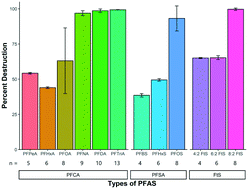Rapid degradation of PFAS in aqueous solutions by reverse vortex flow gliding arc plasma†
Abstract
Poly- and perfluoroalkyl substances (PFAS) are a group of fluorinated organic anthropogenic chemicals that are resistant to degradation. In this paper, non-equilibrium, reverse vortex gliding arc plasma (GAP) discharges in air, nitrogen (N2), and pure oxygen (O2) gases were investigated for the removal of perfluoroalkyl carboxylates (PFCA), perfluoroalkyl sulfonates (PFSA), and fluorotelomer sulfonates (FtS) from liquid solutions in a 1-liter treatment system. At initial concentrations ranging from 0.05 g L−1 to 1 g L−1 significant removal was observed for all PFAS compounds by GAP discharges in air, but the degree of degradation and defluorination was highly dependent on perfluorinated alkyl chain lengths, with all those containing 8 or more perfluorinated carbons achieving greater than 90% removal and often greater than 25% defluorination in one hour of treatment time. Following treatment, a fluorine mass balance was attempted for PFOS (58.3% recovery) and PFOA (98.2% recovery) where only a miniscule portion (5.6% and 4.2%) respectively of the degraded PFOS and PFOA were converted to quantifiable PFAS, while the rest of the fluorine may leave as gaseous species or non-quantifiable PFAS. The non-equilibrium GAP discharge used in this study was found to use similar amounts of energy to other studies using non-equilibrium plasma (150 kJ L−1 to 1000 kJ L−1), which is approximately three to twenty times less than the amount of energy used to evaporate water (∼3000 kJ L−1). Assuming pseudo-first-order kinetics, the figure-of-merit electrical energy per order (EEo) values were calculated to estimate the energy efficiency of the system. The lowest EEo for PFOS was 23.2 kW h m−3 per order and 213.4 kW h m−3 per order for PFOA, similar with existing technologies (which range from 10 to 10 000 kW h m−3 per order). These results indicate that non-thermal air plasma discharges are promising technologies for treatment of PFAS that should be further researched and developed.

- This article is part of the themed collection: Best Papers 2020 – Environmental Science: Water Research & Technology


 Please wait while we load your content...
Please wait while we load your content...